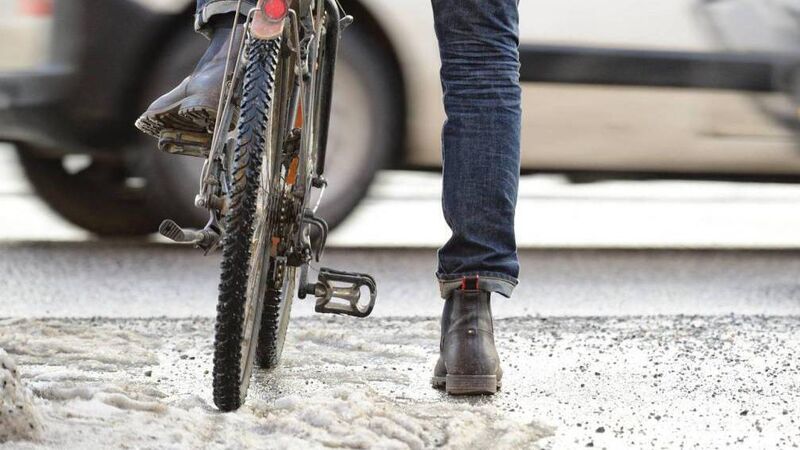It’s time to make cycling in city safer

The best way to make cycling safer is to separate bikes from traffic, says Dr Catherine Conlon
Fatalities on Irish roads continue to rise, and one in 13 deaths are cyclists or drivers/passengers on e-scooters. Added to these are the thousands of serious injuries that befall cyclists on Irish roads.
A report by the Road Safety Authority (RSA), in conjunction with the HSE and Trinity College Dublin last March, documented 4,790 cyclists hospitalised, or about 532 per year, a figure 2.5 times the rate of Gárda Siochána data.
This report, which examined medical data as opposed to Gárda records alone, gives a more accurate picture of the extent to which cyclists are exposed on Irish roads.
This type of data highlights the absurdity on our streets - where we have normalised the imbalance between making cycling a ‘safe’ experience compared to what is a safe level of risk for drivers.
Whereas car safety is constantly being improved, including front and side impact airbags, air-lock brakes, stability controls, overhead airbags, side and front crash-testing, and roof strength tests; as often as not cyclists are protected by a voluntary helmet and a strip of paint.
As we continue to resource active travel in cities, the real question that must be prioritised is: how can we make cycling safer?
The most effective way is to separate bikes and traffic.
A new study on schoolchildren living in London’s ultra-low emission zone (ULEZ) reported they were four times as likely to switch to walking and cycling after its introduction compared with those outside the zones.
The study followed the travel habits of almost 2,000 children over two years. The ULEZ was introduced in an effort to reduce traffic-related pollution, known to affect neurodevelopment, cognitive ability and lung function in children.
The researchers surveyed 1,000 children across 44 schools in central London about how they travelled to school in 2018-19 prior to the ULEZ’s introduction, and then again in 2019-2020 after it was introduced. The same survey was repeated in 1,000 children in Luton, a town with a similar demographic and socioeconomic profile, outside the ULEZ zones.
The results showed four in 10 children in central London, who previously travelled to school by car, then switched to walking, cycling or public transport following the ULEZ introduction. This compared to two out of 10 children in Luton who changed their school journeys over the same period.
One city, where separating cars from traffic has been a priority for decades is Amsterdam. Its Metropolitan region spans 2,580 km2 and houses 2.5 million people. Yet, almost half (45%) of trips into and out of and within the region are made by foot or bicycle.
Imagine if half of all trips of the 1.3m people in Dublin were made by bike or foot - with cycle lanes comprehensively separated from traffic - how much safer our roads would be.
As we wait for infrastructure to improve, cycling must be made safer by educating drivers.
The RSA have developed a campaign to encourage all road users to keep cyclists safe on our roads. Primarily, it focuses on reminding motorists to keep a safe distance when overtaking cyclists on urban or rural roads. They should give a 1-metre clearance when overtaking a cyclist in speed zones that are 50kph or under, and at least 1.5 metres in speed zones over 50kph.
Cycling UK have a far more comprehensive document, Sharing The Road With Cyclists: Tips For Drivers, that highlights the reality of cycling on roads that are shared with cars. The evidence shows cyclists’ behaviour is less likely to be at fault in reported collisions than drivers. Added to that, cyclists suffer not only from impact collisions, but are regularly subjected to off-putting ‘near misses’ too.
A paper in the Journal of Transport Health (2015) summed up the daily risks to cyclists: “Frightening or annoying non-injury incidents, unlike slight injuries, are an everyday experience for most people cycling in the UK. For regular cyclists, ‘very scary’ incidents are on average a weekly experience, with deliberate aggression experienced monthly.”
This is exactly my experience. Pushed off the road when drivers blithely turn left while you are cycling across a junction; cars coming within a hair’s breath of clipping your pedals; drivers throwing car doors open in front of you - these are all weekly occurrences.
It suggests much more effort should be made to instil in drivers a better understanding of cyclists and how to drive safely around them.
We know, in general, drivers tend to stereotype cyclists negatively. Evidence shows they can be critical of their actions without understanding why they behave as they do, that they find them unpredictable, and see them as an ‘out’ group, who all exhibit the same ‘faults’.
Cycling UK has identified this range of actions from drivers that put cyclists at risk:
- 1. Failing to look before turning at junctions and/ or roundabouts;
- 2. Speeding
- 3. Distraction (e.g. by mobile phones)
- 4. Close overtaking (including on bends);
- 5. Opening car doors without looking.
Also, many drivers are aggravated when they find cyclists ‘in the way’- e.g. riding away from the pavement or in the middle of a traffic lane. This may be because of surface defects and drain covers on the side of the road, or to move out to deter drivers from overtaking them when there is not enough room to do so safely.
Equally, cyclists may cycle two abreast to deter drivers from overtaking them when the manoeuvre could be dangerous.
Cycling UK recommends that “education of drivers should focus not on helping them to predict cyclist behaviour, but on understanding what circumstances will influence that behaviour” adding: “Drivers’ education should include advice on how to respond when encountering cyclists at certain types of road feature. More clearly defining the appropriate responses may assist drivers in knowing how to behave more considerately and in resisting social pressure from other drivers to force their way pass cyclists,” adds Cycling UK.
Political will to make cycling safer, including the removal of cars from cities; comprehensive separation of two-wheeled vehicles from all other traffic; and an energetic, innovative campaign to educate and inform drivers; would have immediate benefits in reducing the risks to cyclists already playing Russian roulette on our roads. Added to that, it would incentivise thousands of other potential cyclists to leave their cars at home to travel short distances in cities and towns.
Brent Toderian, International consultant on Advanced Urbanism and Vancouver’s former Director of City Planning, writing on X, summed up the huge advantages of more and more people cycling in cities: “Less local traffic. Lower emissions. Less noise. Better physical health. Better mental health. Better mood. Happier. Better school performance. Less public cost. Less space needed.”
A well-resourced campaign is urgently required to educate drivers.







 App?
App?







